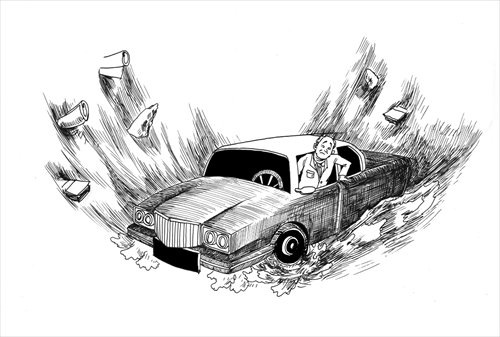Liquidity trap theory doesn’t apply to China

Illustration: Luo Xuan/GT
Debates have arisen over whether China is falling into a liquidity trap after a senior official at China's central bank recently warned of that possibility if firms remain reluctant to invest even as the central bank injects more money to the market.
A liquidity trap refers to a situation where cash injection by monetary authorities fails to decrease interest rates and generate more investments, making monetary policy ineffective. But the theory has never been verified in practice and there has been no accurate explanation of how the trap is created.
China's M1, a narrow measure of money supply which includes only the most liquid assets surged 24.6 percent year-one-year in June, while M2, a broad-based measure of money supply which includes M1 and time deposits, rose 11.8 percent.
According to Sheng Songcheng, director of the statistics and analysis department at the People's Bank of China, the growing divergence between M1 and M2 growth shows that firms may be falling into a liquidity trap. But it appears the theory may be a less than convincing explanation of what is happening in China's financial market. This is because China's financial market is not a full market-based system, with the central bank still controlling interest rates and directly managing risk pricing on loans and deposits of the commercial banks. What's more, the benchmark interest rate adopted by China is not that same as the money market lending rate applied in the US and European countries. Up to now, the theory of liquidity trap has never been proven in these Western countries, so applying it to a Chinese context is not of much value.
The key questions are, why is there a great divergence between M1 and M2 growth, and how will that situation impact China's economy?
The difference between M1 and M2 is that M2 covers both M1 and time deposits. The widening divergence between the two is due to the different pacing of their growth. While growth of time deposits has slowed, cash and demand deposits have quickly expanded.
Two major factors have contributed to a slower growth in time deposits. First, the yuan has entered a depreciation cycle, which has resulted in a decrease of foreign capital inflow and rapid decline of forex receipts at financial institutions. Second, with continuous decreases on interest rates on time deposits, the margin between interest rates on demand deposit and time deposit has narrowed, which has prompted some depositors to pull money from their time deposit accounts and place it into demand deposit accounts upon maturity or invest it in the property market. Given the two factors, time account growth will continue to slow.
There are also two factors that may account for the surge in M1. Following the stock market slump last year, companies and individual investors withdrew from medium- and long-term investment, preferring to make short-term investments with liquid demand deposits. On the other hand, local governments rolled out stimulus policies cutting the minimum down payment on property to a historically low level to encourage residents to buy more homes, investments that would have been made with money in their time deposit accounts or stock market investments. Therefore, property developers have increased demand deposits. However, except for those in first- and second-tier cities, developers are not optimistic about the future market and remain reluctant to invest more. As the downward pressure on China's economy persists, companies in other sectors are also reluctant to increase investment in real economy and would rather invest the money in their demand deposit accounts in wealth management products. This will naturally result in growing demand deposits held by firms.
Given the current circumstance, monetary policy has proved to be less effective than hoped for. No matter how the central bank eases monetary policies and cuts interest rates to pump up more liquidity, it appears the capital will not flow into the real economy. So long as the economy relies on increased investment in the property market, the real economy will face greater challenges.
It therefore appears that the major problem with China's economy is not the fear of a liquidity trap but whether China can abandon the path of relying on the property sector to drive the economy. Unless this problem is recognized, it will be difficult for China to overcome its economic challenges.
The author is a professor with the College of Economics at Qingdao University. bizopinion@globaltimes.com.cn